Analyzing Medication Errors and Falls in Nursing Home Environments
VerifiedAdded on 2020/12/24
|11
|3178
|75
Essay
AI Summary
This essay provides a comprehensive overview of medical concerns within nursing homes, focusing specifically on medication errors and falls. It begins by defining medication errors, emphasizing their preventable nature and potential for adverse patient outcomes, including incomplete treatment, injury, and other ailments. The essay explores the concept of medication errors, examining various types such as prescribing errors, dose errors, and monitoring errors, along with their causes, including environmental factors, incomplete patient information, systematic issues, and memory lapses. It further analyzes the significance of medication errors, the role of nurses in preventing them, and the importance of human factors in healthcare. The essay then delves into different types of medication errors and their causes. Finally, it outlines various strategies for reducing medication errors, including the use of novel technologies and systems within healthcare, actions concerning polypharmacy, high-risk situations, and care transitions, and the application of World Health Organisation measures. The essay aims to determine the medical concerns like falls in nursing homes medication errors.
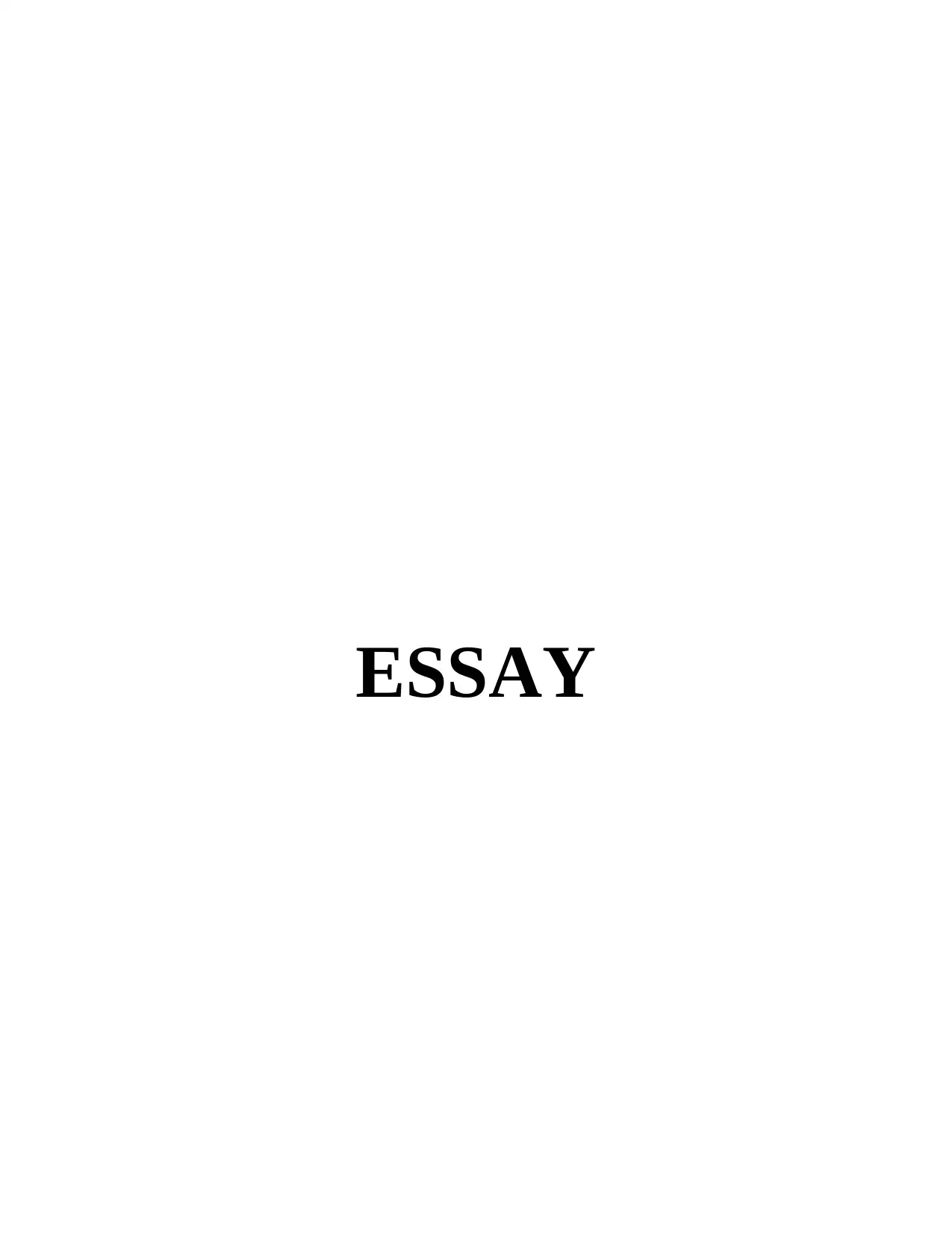
ESSAY
Paraphrase This Document
Need a fresh take? Get an instant paraphrase of this document with our AI Paraphraser

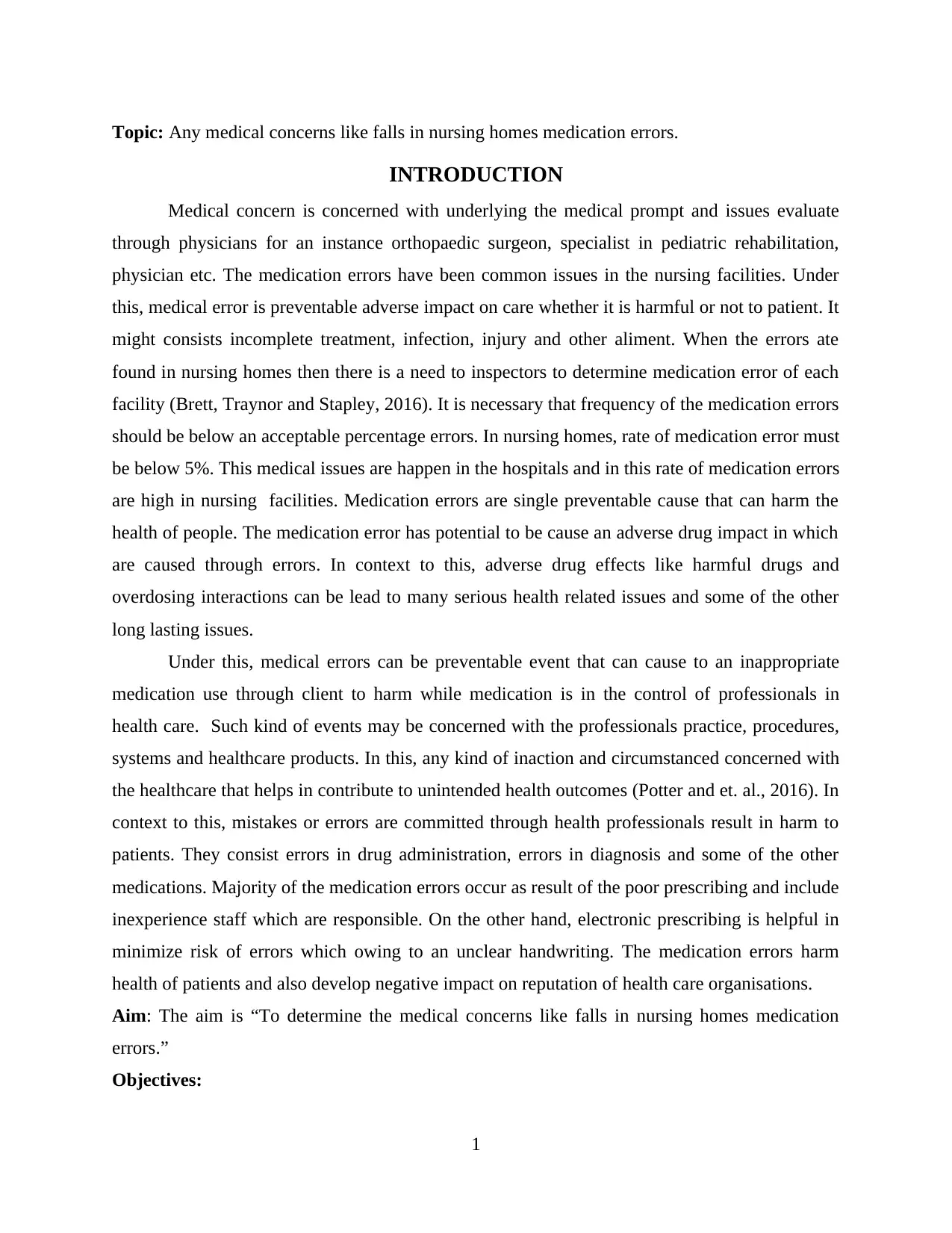
Topic: Any medical concerns like falls in nursing homes medication errors.
INTRODUCTION
Medical concern is concerned with underlying the medical prompt and issues evaluate
through physicians for an instance orthopaedic surgeon, specialist in pediatric rehabilitation,
physician etc. The medication errors have been common issues in the nursing facilities. Under
this, medical error is preventable adverse impact on care whether it is harmful or not to patient. It
might consists incomplete treatment, infection, injury and other aliment. When the errors ate
found in nursing homes then there is a need to inspectors to determine medication error of each
facility (Brett, Traynor and Stapley, 2016). It is necessary that frequency of the medication errors
should be below an acceptable percentage errors. In nursing homes, rate of medication error must
be below 5%. This medical issues are happen in the hospitals and in this rate of medication errors
are high in nursing facilities. Medication errors are single preventable cause that can harm the
health of people. The medication error has potential to be cause an adverse drug impact in which
are caused through errors. In context to this, adverse drug effects like harmful drugs and
overdosing interactions can be lead to many serious health related issues and some of the other
long lasting issues.
Under this, medical errors can be preventable event that can cause to an inappropriate
medication use through client to harm while medication is in the control of professionals in
health care. Such kind of events may be concerned with the professionals practice, procedures,
systems and healthcare products. In this, any kind of inaction and circumstanced concerned with
the healthcare that helps in contribute to unintended health outcomes (Potter and et. al., 2016). In
context to this, mistakes or errors are committed through health professionals result in harm to
patients. They consist errors in drug administration, errors in diagnosis and some of the other
medications. Majority of the medication errors occur as result of the poor prescribing and include
inexperience staff which are responsible. On the other hand, electronic prescribing is helpful in
minimize risk of errors which owing to an unclear handwriting. The medication errors harm
health of patients and also develop negative impact on reputation of health care organisations.
Aim: The aim is “To determine the medical concerns like falls in nursing homes medication
errors.”
Objectives:
1
INTRODUCTION
Medical concern is concerned with underlying the medical prompt and issues evaluate
through physicians for an instance orthopaedic surgeon, specialist in pediatric rehabilitation,
physician etc. The medication errors have been common issues in the nursing facilities. Under
this, medical error is preventable adverse impact on care whether it is harmful or not to patient. It
might consists incomplete treatment, infection, injury and other aliment. When the errors ate
found in nursing homes then there is a need to inspectors to determine medication error of each
facility (Brett, Traynor and Stapley, 2016). It is necessary that frequency of the medication errors
should be below an acceptable percentage errors. In nursing homes, rate of medication error must
be below 5%. This medical issues are happen in the hospitals and in this rate of medication errors
are high in nursing facilities. Medication errors are single preventable cause that can harm the
health of people. The medication error has potential to be cause an adverse drug impact in which
are caused through errors. In context to this, adverse drug effects like harmful drugs and
overdosing interactions can be lead to many serious health related issues and some of the other
long lasting issues.
Under this, medical errors can be preventable event that can cause to an inappropriate
medication use through client to harm while medication is in the control of professionals in
health care. Such kind of events may be concerned with the professionals practice, procedures,
systems and healthcare products. In this, any kind of inaction and circumstanced concerned with
the healthcare that helps in contribute to unintended health outcomes (Potter and et. al., 2016). In
context to this, mistakes or errors are committed through health professionals result in harm to
patients. They consist errors in drug administration, errors in diagnosis and some of the other
medications. Majority of the medication errors occur as result of the poor prescribing and include
inexperience staff which are responsible. On the other hand, electronic prescribing is helpful in
minimize risk of errors which owing to an unclear handwriting. The medication errors harm
health of patients and also develop negative impact on reputation of health care organisations.
Aim: The aim is “To determine the medical concerns like falls in nursing homes medication
errors.”
Objectives:
1
⊘ This is a preview!⊘
Do you want full access?
Subscribe today to unlock all pages.

Trusted by 1+ million students worldwide
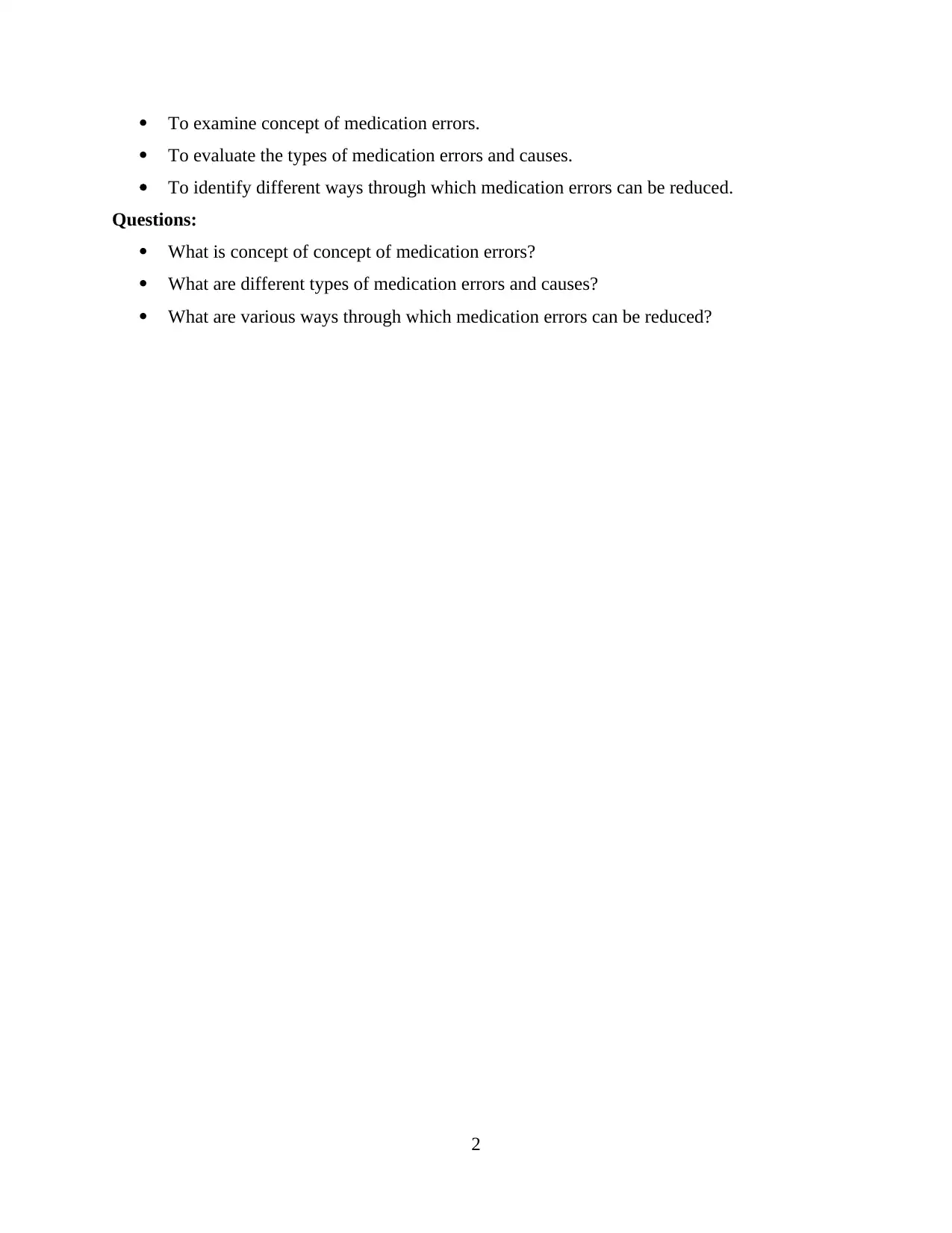
To examine concept of medication errors.
To evaluate the types of medication errors and causes.
To identify different ways through which medication errors can be reduced.
Questions:
What is concept of concept of medication errors?
What are different types of medication errors and causes?
What are various ways through which medication errors can be reduced?
2
To evaluate the types of medication errors and causes.
To identify different ways through which medication errors can be reduced.
Questions:
What is concept of concept of medication errors?
What are different types of medication errors and causes?
What are various ways through which medication errors can be reduced?
2
Paraphrase This Document
Need a fresh take? Get an instant paraphrase of this document with our AI Paraphraser
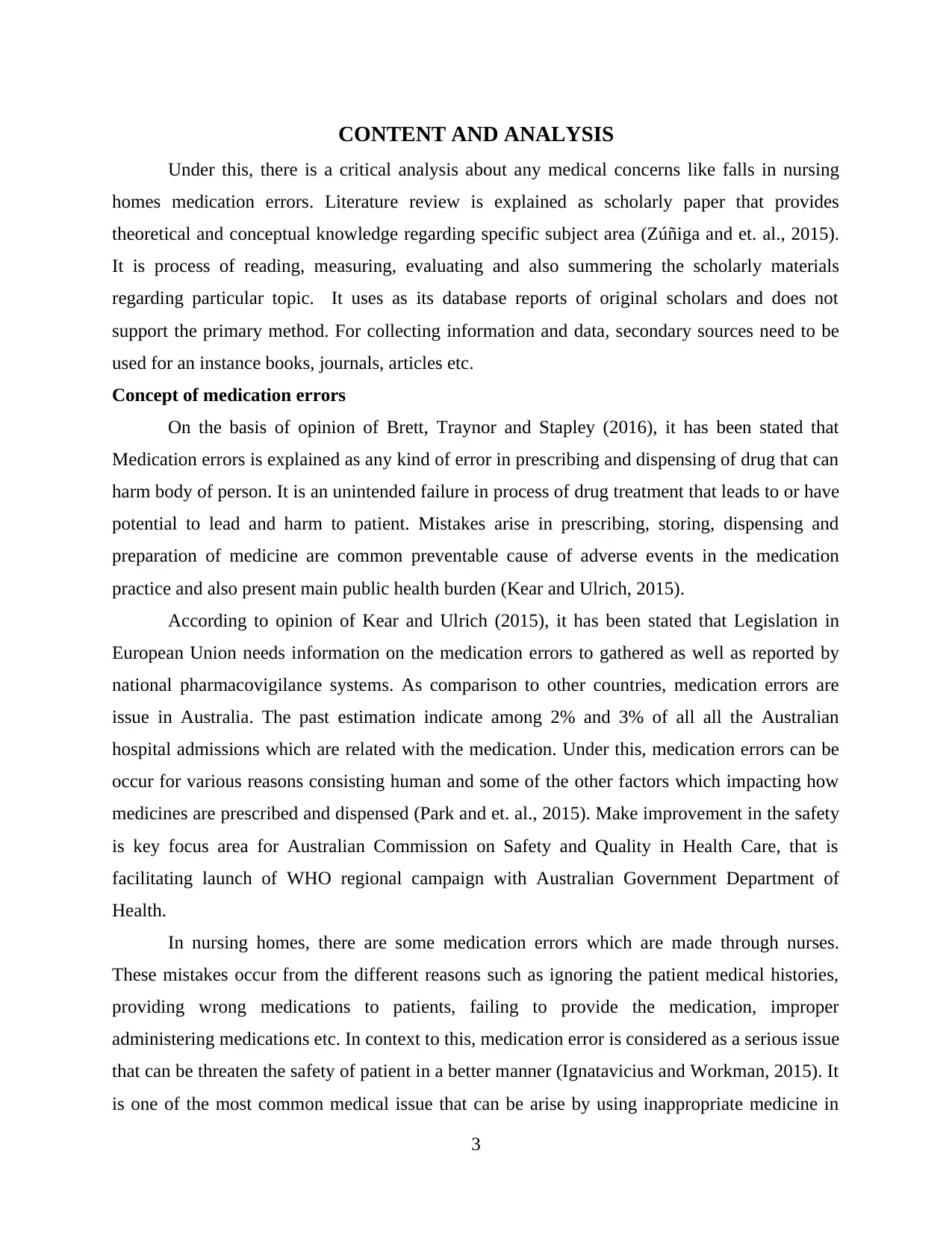
CONTENT AND ANALYSIS
Under this, there is a critical analysis about any medical concerns like falls in nursing
homes medication errors. Literature review is explained as scholarly paper that provides
theoretical and conceptual knowledge regarding specific subject area (Zúñiga and et. al., 2015).
It is process of reading, measuring, evaluating and also summering the scholarly materials
regarding particular topic. It uses as its database reports of original scholars and does not
support the primary method. For collecting information and data, secondary sources need to be
used for an instance books, journals, articles etc.
Concept of medication errors
On the basis of opinion of Brett, Traynor and Stapley (2016), it has been stated that
Medication errors is explained as any kind of error in prescribing and dispensing of drug that can
harm body of person. It is an unintended failure in process of drug treatment that leads to or have
potential to lead and harm to patient. Mistakes arise in prescribing, storing, dispensing and
preparation of medicine are common preventable cause of adverse events in the medication
practice and also present main public health burden (Kear and Ulrich, 2015).
According to opinion of Kear and Ulrich (2015), it has been stated that Legislation in
European Union needs information on the medication errors to gathered as well as reported by
national pharmacovigilance systems. As comparison to other countries, medication errors are
issue in Australia. The past estimation indicate among 2% and 3% of all all the Australian
hospital admissions which are related with the medication. Under this, medication errors can be
occur for various reasons consisting human and some of the other factors which impacting how
medicines are prescribed and dispensed (Park and et. al., 2015). Make improvement in the safety
is key focus area for Australian Commission on Safety and Quality in Health Care, that is
facilitating launch of WHO regional campaign with Australian Government Department of
Health.
In nursing homes, there are some medication errors which are made through nurses.
These mistakes occur from the different reasons such as ignoring the patient medical histories,
providing wrong medications to patients, failing to provide the medication, improper
administering medications etc. In context to this, medication error is considered as a serious issue
that can be threaten the safety of patient in a better manner (Ignatavicius and Workman, 2015). It
is one of the most common medical issue that can be arise by using inappropriate medicine in
3
Under this, there is a critical analysis about any medical concerns like falls in nursing
homes medication errors. Literature review is explained as scholarly paper that provides
theoretical and conceptual knowledge regarding specific subject area (Zúñiga and et. al., 2015).
It is process of reading, measuring, evaluating and also summering the scholarly materials
regarding particular topic. It uses as its database reports of original scholars and does not
support the primary method. For collecting information and data, secondary sources need to be
used for an instance books, journals, articles etc.
Concept of medication errors
On the basis of opinion of Brett, Traynor and Stapley (2016), it has been stated that
Medication errors is explained as any kind of error in prescribing and dispensing of drug that can
harm body of person. It is an unintended failure in process of drug treatment that leads to or have
potential to lead and harm to patient. Mistakes arise in prescribing, storing, dispensing and
preparation of medicine are common preventable cause of adverse events in the medication
practice and also present main public health burden (Kear and Ulrich, 2015).
According to opinion of Kear and Ulrich (2015), it has been stated that Legislation in
European Union needs information on the medication errors to gathered as well as reported by
national pharmacovigilance systems. As comparison to other countries, medication errors are
issue in Australia. The past estimation indicate among 2% and 3% of all all the Australian
hospital admissions which are related with the medication. Under this, medication errors can be
occur for various reasons consisting human and some of the other factors which impacting how
medicines are prescribed and dispensed (Park and et. al., 2015). Make improvement in the safety
is key focus area for Australian Commission on Safety and Quality in Health Care, that is
facilitating launch of WHO regional campaign with Australian Government Department of
Health.
In nursing homes, there are some medication errors which are made through nurses.
These mistakes occur from the different reasons such as ignoring the patient medical histories,
providing wrong medications to patients, failing to provide the medication, improper
administering medications etc. In context to this, medication error is considered as a serious issue
that can be threaten the safety of patient in a better manner (Ignatavicius and Workman, 2015). It
is one of the most common medical issue that can be arise by using inappropriate medicine in
3
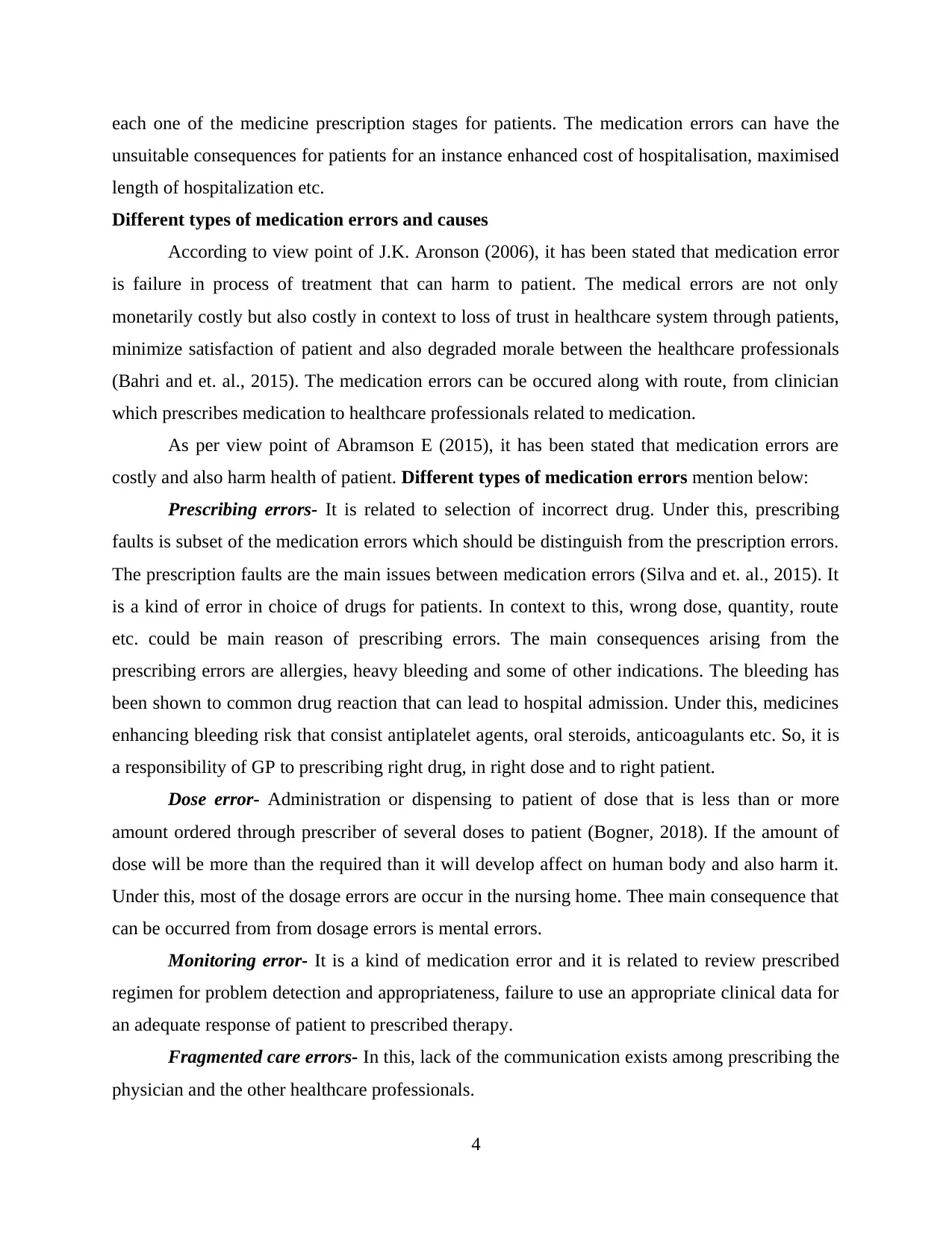
each one of the medicine prescription stages for patients. The medication errors can have the
unsuitable consequences for patients for an instance enhanced cost of hospitalisation, maximised
length of hospitalization etc.
Different types of medication errors and causes
According to view point of J.K. Aronson (2006), it has been stated that medication error
is failure in process of treatment that can harm to patient. The medical errors are not only
monetarily costly but also costly in context to loss of trust in healthcare system through patients,
minimize satisfaction of patient and also degraded morale between the healthcare professionals
(Bahri and et. al., 2015). The medication errors can be occured along with route, from clinician
which prescribes medication to healthcare professionals related to medication.
As per view point of Abramson E (2015), it has been stated that medication errors are
costly and also harm health of patient. Different types of medication errors mention below:
Prescribing errors- It is related to selection of incorrect drug. Under this, prescribing
faults is subset of the medication errors which should be distinguish from the prescription errors.
The prescription faults are the main issues between medication errors (Silva and et. al., 2015). It
is a kind of error in choice of drugs for patients. In context to this, wrong dose, quantity, route
etc. could be main reason of prescribing errors. The main consequences arising from the
prescribing errors are allergies, heavy bleeding and some of other indications. The bleeding has
been shown to common drug reaction that can lead to hospital admission. Under this, medicines
enhancing bleeding risk that consist antiplatelet agents, oral steroids, anticoagulants etc. So, it is
a responsibility of GP to prescribing right drug, in right dose and to right patient.
Dose error- Administration or dispensing to patient of dose that is less than or more
amount ordered through prescriber of several doses to patient (Bogner, 2018). If the amount of
dose will be more than the required than it will develop affect on human body and also harm it.
Under this, most of the dosage errors are occur in the nursing home. Thee main consequence that
can be occurred from from dosage errors is mental errors.
Monitoring error- It is a kind of medication error and it is related to review prescribed
regimen for problem detection and appropriateness, failure to use an appropriate clinical data for
an adequate response of patient to prescribed therapy.
Fragmented care errors- In this, lack of the communication exists among prescribing the
physician and the other healthcare professionals.
4
unsuitable consequences for patients for an instance enhanced cost of hospitalisation, maximised
length of hospitalization etc.
Different types of medication errors and causes
According to view point of J.K. Aronson (2006), it has been stated that medication error
is failure in process of treatment that can harm to patient. The medical errors are not only
monetarily costly but also costly in context to loss of trust in healthcare system through patients,
minimize satisfaction of patient and also degraded morale between the healthcare professionals
(Bahri and et. al., 2015). The medication errors can be occured along with route, from clinician
which prescribes medication to healthcare professionals related to medication.
As per view point of Abramson E (2015), it has been stated that medication errors are
costly and also harm health of patient. Different types of medication errors mention below:
Prescribing errors- It is related to selection of incorrect drug. Under this, prescribing
faults is subset of the medication errors which should be distinguish from the prescription errors.
The prescription faults are the main issues between medication errors (Silva and et. al., 2015). It
is a kind of error in choice of drugs for patients. In context to this, wrong dose, quantity, route
etc. could be main reason of prescribing errors. The main consequences arising from the
prescribing errors are allergies, heavy bleeding and some of other indications. The bleeding has
been shown to common drug reaction that can lead to hospital admission. Under this, medicines
enhancing bleeding risk that consist antiplatelet agents, oral steroids, anticoagulants etc. So, it is
a responsibility of GP to prescribing right drug, in right dose and to right patient.
Dose error- Administration or dispensing to patient of dose that is less than or more
amount ordered through prescriber of several doses to patient (Bogner, 2018). If the amount of
dose will be more than the required than it will develop affect on human body and also harm it.
Under this, most of the dosage errors are occur in the nursing home. Thee main consequence that
can be occurred from from dosage errors is mental errors.
Monitoring error- It is a kind of medication error and it is related to review prescribed
regimen for problem detection and appropriateness, failure to use an appropriate clinical data for
an adequate response of patient to prescribed therapy.
Fragmented care errors- In this, lack of the communication exists among prescribing the
physician and the other healthcare professionals.
4
⊘ This is a preview!⊘
Do you want full access?
Subscribe today to unlock all pages.

Trusted by 1+ million students worldwide
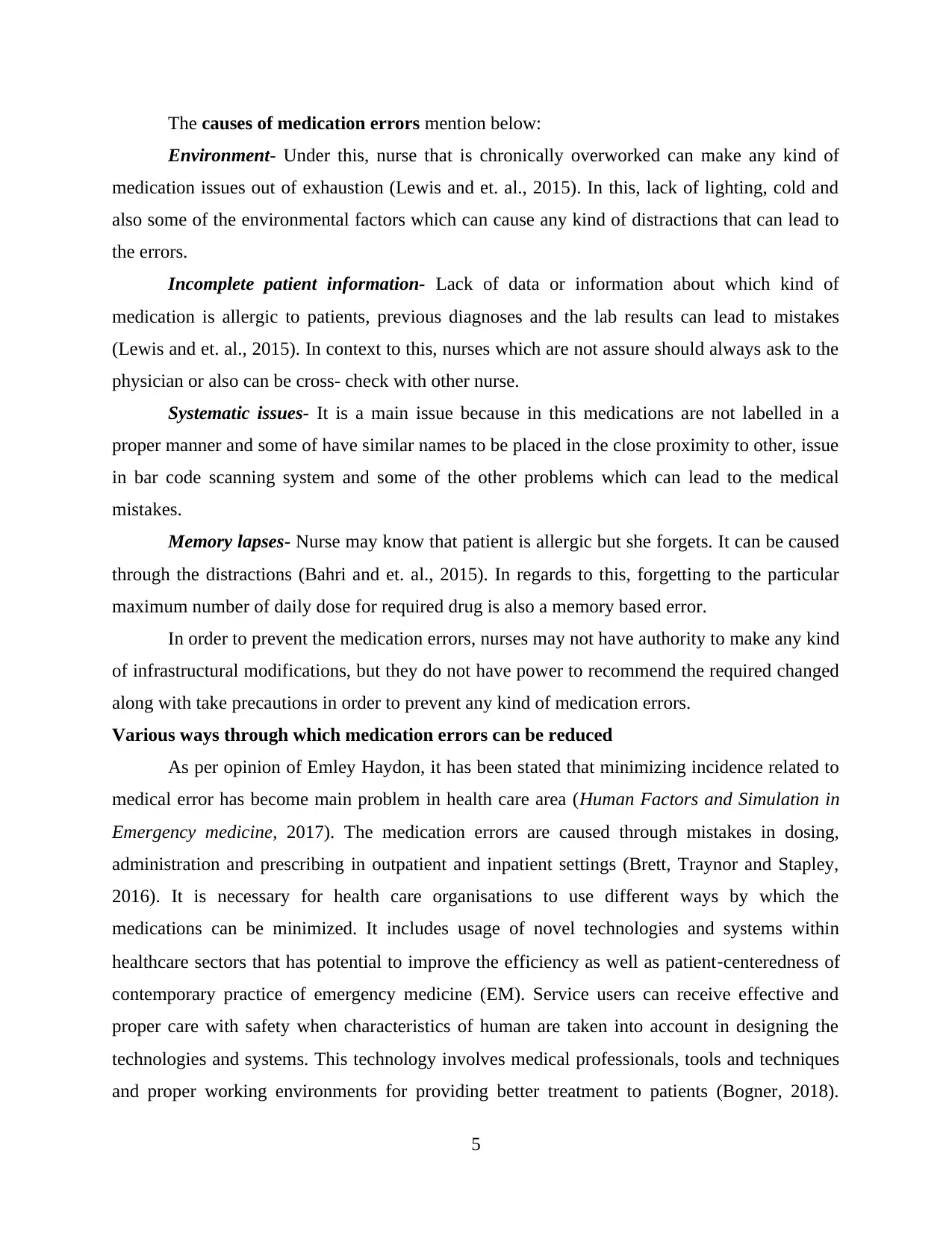
The causes of medication errors mention below:
Environment- Under this, nurse that is chronically overworked can make any kind of
medication issues out of exhaustion (Lewis and et. al., 2015). In this, lack of lighting, cold and
also some of the environmental factors which can cause any kind of distractions that can lead to
the errors.
Incomplete patient information- Lack of data or information about which kind of
medication is allergic to patients, previous diagnoses and the lab results can lead to mistakes
(Lewis and et. al., 2015). In context to this, nurses which are not assure should always ask to the
physician or also can be cross- check with other nurse.
Systematic issues- It is a main issue because in this medications are not labelled in a
proper manner and some of have similar names to be placed in the close proximity to other, issue
in bar code scanning system and some of the other problems which can lead to the medical
mistakes.
Memory lapses- Nurse may know that patient is allergic but she forgets. It can be caused
through the distractions (Bahri and et. al., 2015). In regards to this, forgetting to the particular
maximum number of daily dose for required drug is also a memory based error.
In order to prevent the medication errors, nurses may not have authority to make any kind
of infrastructural modifications, but they do not have power to recommend the required changed
along with take precautions in order to prevent any kind of medication errors.
Various ways through which medication errors can be reduced
As per opinion of Emley Haydon, it has been stated that minimizing incidence related to
medical error has become main problem in health care area (Human Factors and Simulation in
Emergency medicine, 2017). The medication errors are caused through mistakes in dosing,
administration and prescribing in outpatient and inpatient settings (Brett, Traynor and Stapley,
2016). It is necessary for health care organisations to use different ways by which the
medications can be minimized. It includes usage of novel technologies and systems within
healthcare sectors that has potential to improve the efficiency as well as patient‐centeredness of
contemporary practice of emergency medicine (EM). Service users can receive effective and
proper care with safety when characteristics of human are taken into account in designing the
technologies and systems. This technology involves medical professionals, tools and techniques
and proper working environments for providing better treatment to patients (Bogner, 2018).
5
Environment- Under this, nurse that is chronically overworked can make any kind of
medication issues out of exhaustion (Lewis and et. al., 2015). In this, lack of lighting, cold and
also some of the environmental factors which can cause any kind of distractions that can lead to
the errors.
Incomplete patient information- Lack of data or information about which kind of
medication is allergic to patients, previous diagnoses and the lab results can lead to mistakes
(Lewis and et. al., 2015). In context to this, nurses which are not assure should always ask to the
physician or also can be cross- check with other nurse.
Systematic issues- It is a main issue because in this medications are not labelled in a
proper manner and some of have similar names to be placed in the close proximity to other, issue
in bar code scanning system and some of the other problems which can lead to the medical
mistakes.
Memory lapses- Nurse may know that patient is allergic but she forgets. It can be caused
through the distractions (Bahri and et. al., 2015). In regards to this, forgetting to the particular
maximum number of daily dose for required drug is also a memory based error.
In order to prevent the medication errors, nurses may not have authority to make any kind
of infrastructural modifications, but they do not have power to recommend the required changed
along with take precautions in order to prevent any kind of medication errors.
Various ways through which medication errors can be reduced
As per opinion of Emley Haydon, it has been stated that minimizing incidence related to
medical error has become main problem in health care area (Human Factors and Simulation in
Emergency medicine, 2017). The medication errors are caused through mistakes in dosing,
administration and prescribing in outpatient and inpatient settings (Brett, Traynor and Stapley,
2016). It is necessary for health care organisations to use different ways by which the
medications can be minimized. It includes usage of novel technologies and systems within
healthcare sectors that has potential to improve the efficiency as well as patient‐centeredness of
contemporary practice of emergency medicine (EM). Service users can receive effective and
proper care with safety when characteristics of human are taken into account in designing the
technologies and systems. This technology involves medical professionals, tools and techniques
and proper working environments for providing better treatment to patients (Bogner, 2018).
5
Paraphrase This Document
Need a fresh take? Get an instant paraphrase of this document with our AI Paraphraser
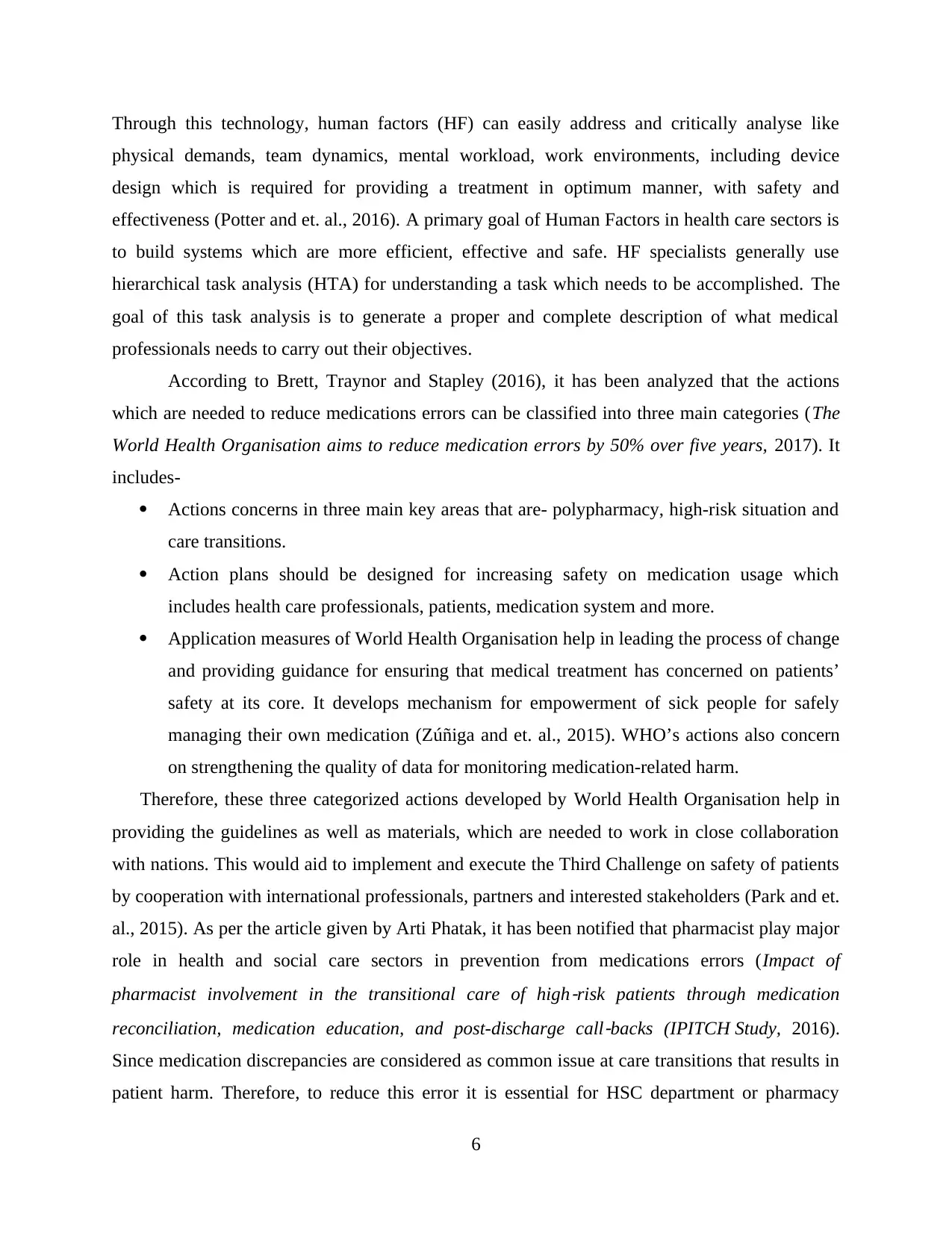
Through this technology, human factors (HF) can easily address and critically analyse like
physical demands, team dynamics, mental workload, work environments, including device
design which is required for providing a treatment in optimum manner, with safety and
effectiveness (Potter and et. al., 2016). A primary goal of Human Factors in health care sectors is
to build systems which are more efficient, effective and safe. HF specialists generally use
hierarchical task analysis (HTA) for understanding a task which needs to be accomplished. The
goal of this task analysis is to generate a proper and complete description of what medical
professionals needs to carry out their objectives.
According to Brett, Traynor and Stapley (2016), it has been analyzed that the actions
which are needed to reduce medications errors can be classified into three main categories (The
World Health Organisation aims to reduce medication errors by 50% over five years, 2017). It
includes-
Actions concerns in three main key areas that are- polypharmacy, high-risk situation and
care transitions.
Action plans should be designed for increasing safety on medication usage which
includes health care professionals, patients, medication system and more.
Application measures of World Health Organisation help in leading the process of change
and providing guidance for ensuring that medical treatment has concerned on patients’
safety at its core. It develops mechanism for empowerment of sick people for safely
managing their own medication (Zúñiga and et. al., 2015). WHO’s actions also concern
on strengthening the quality of data for monitoring medication-related harm.
Therefore, these three categorized actions developed by World Health Organisation help in
providing the guidelines as well as materials, which are needed to work in close collaboration
with nations. This would aid to implement and execute the Third Challenge on safety of patients
by cooperation with international professionals, partners and interested stakeholders (Park and et.
al., 2015). As per the article given by Arti Phatak, it has been notified that pharmacist play major
role in health and social care sectors in prevention from medications errors (Impact of
pharmacist involvement in the transitional care of high
‐risk patients through medication
reconciliation, medication education, and post-discharge call
‐backs (IPITCH Study, 2016).
Since medication discrepancies are considered as common issue at care transitions that results in
patient harm. Therefore, to reduce this error it is essential for HSC department or pharmacy
6
physical demands, team dynamics, mental workload, work environments, including device
design which is required for providing a treatment in optimum manner, with safety and
effectiveness (Potter and et. al., 2016). A primary goal of Human Factors in health care sectors is
to build systems which are more efficient, effective and safe. HF specialists generally use
hierarchical task analysis (HTA) for understanding a task which needs to be accomplished. The
goal of this task analysis is to generate a proper and complete description of what medical
professionals needs to carry out their objectives.
According to Brett, Traynor and Stapley (2016), it has been analyzed that the actions
which are needed to reduce medications errors can be classified into three main categories (The
World Health Organisation aims to reduce medication errors by 50% over five years, 2017). It
includes-
Actions concerns in three main key areas that are- polypharmacy, high-risk situation and
care transitions.
Action plans should be designed for increasing safety on medication usage which
includes health care professionals, patients, medication system and more.
Application measures of World Health Organisation help in leading the process of change
and providing guidance for ensuring that medical treatment has concerned on patients’
safety at its core. It develops mechanism for empowerment of sick people for safely
managing their own medication (Zúñiga and et. al., 2015). WHO’s actions also concern
on strengthening the quality of data for monitoring medication-related harm.
Therefore, these three categorized actions developed by World Health Organisation help in
providing the guidelines as well as materials, which are needed to work in close collaboration
with nations. This would aid to implement and execute the Third Challenge on safety of patients
by cooperation with international professionals, partners and interested stakeholders (Park and et.
al., 2015). As per the article given by Arti Phatak, it has been notified that pharmacist play major
role in health and social care sectors in prevention from medications errors (Impact of
pharmacist involvement in the transitional care of high
‐risk patients through medication
reconciliation, medication education, and post-discharge call
‐backs (IPITCH Study, 2016).
Since medication discrepancies are considered as common issue at care transitions that results in
patient harm. Therefore, to reduce this error it is essential for HSC department or pharmacy
6
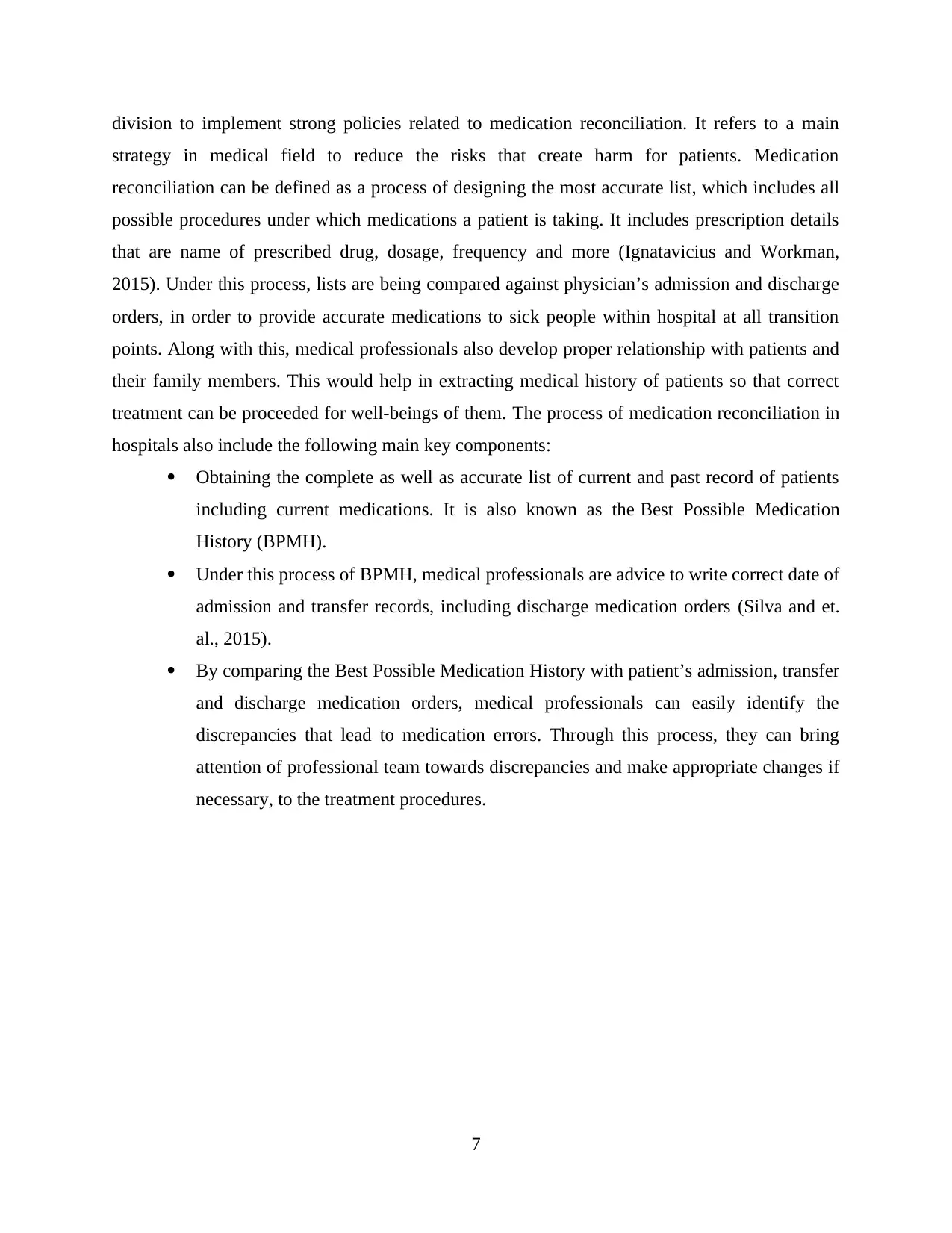
division to implement strong policies related to medication reconciliation. It refers to a main
strategy in medical field to reduce the risks that create harm for patients. Medication
reconciliation can be defined as a process of designing the most accurate list, which includes all
possible procedures under which medications a patient is taking. It includes prescription details
that are name of prescribed drug, dosage, frequency and more (Ignatavicius and Workman,
2015). Under this process, lists are being compared against physician’s admission and discharge
orders, in order to provide accurate medications to sick people within hospital at all transition
points. Along with this, medical professionals also develop proper relationship with patients and
their family members. This would help in extracting medical history of patients so that correct
treatment can be proceeded for well-beings of them. The process of medication reconciliation in
hospitals also include the following main key components:
Obtaining the complete as well as accurate list of current and past record of patients
including current medications. It is also known as the Best Possible Medication
History (BPMH).
Under this process of BPMH, medical professionals are advice to write correct date of
admission and transfer records, including discharge medication orders (Silva and et.
al., 2015).
By comparing the Best Possible Medication History with patient’s admission, transfer
and discharge medication orders, medical professionals can easily identify the
discrepancies that lead to medication errors. Through this process, they can bring
attention of professional team towards discrepancies and make appropriate changes if
necessary, to the treatment procedures.
7
strategy in medical field to reduce the risks that create harm for patients. Medication
reconciliation can be defined as a process of designing the most accurate list, which includes all
possible procedures under which medications a patient is taking. It includes prescription details
that are name of prescribed drug, dosage, frequency and more (Ignatavicius and Workman,
2015). Under this process, lists are being compared against physician’s admission and discharge
orders, in order to provide accurate medications to sick people within hospital at all transition
points. Along with this, medical professionals also develop proper relationship with patients and
their family members. This would help in extracting medical history of patients so that correct
treatment can be proceeded for well-beings of them. The process of medication reconciliation in
hospitals also include the following main key components:
Obtaining the complete as well as accurate list of current and past record of patients
including current medications. It is also known as the Best Possible Medication
History (BPMH).
Under this process of BPMH, medical professionals are advice to write correct date of
admission and transfer records, including discharge medication orders (Silva and et.
al., 2015).
By comparing the Best Possible Medication History with patient’s admission, transfer
and discharge medication orders, medical professionals can easily identify the
discrepancies that lead to medication errors. Through this process, they can bring
attention of professional team towards discrepancies and make appropriate changes if
necessary, to the treatment procedures.
7
⊘ This is a preview!⊘
Do you want full access?
Subscribe today to unlock all pages.

Trusted by 1+ million students worldwide
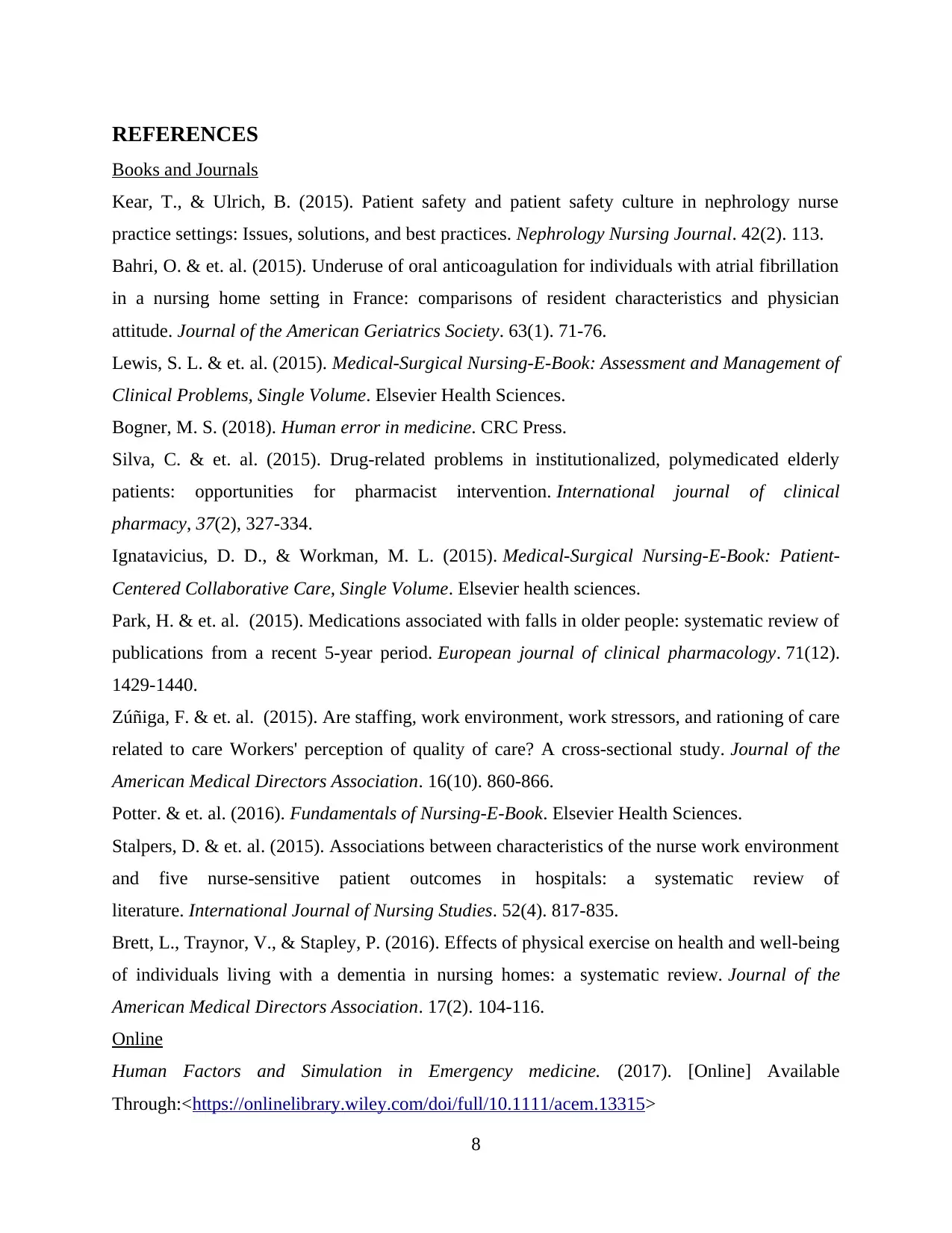
REFERENCES
Books and Journals
Kear, T., & Ulrich, B. (2015). Patient safety and patient safety culture in nephrology nurse
practice settings: Issues, solutions, and best practices. Nephrology Nursing Journal. 42(2). 113.
Bahri, O. & et. al. (2015). Underuse of oral anticoagulation for individuals with atrial fibrillation
in a nursing home setting in France: comparisons of resident characteristics and physician
attitude. Journal of the American Geriatrics Society. 63(1). 71-76.
Lewis, S. L. & et. al. (2015). Medical-Surgical Nursing-E-Book: Assessment and Management of
Clinical Problems, Single Volume. Elsevier Health Sciences.
Bogner, M. S. (2018). Human error in medicine. CRC Press.
Silva, C. & et. al. (2015). Drug-related problems in institutionalized, polymedicated elderly
patients: opportunities for pharmacist intervention. International journal of clinical
pharmacy, 37(2), 327-334.
Ignatavicius, D. D., & Workman, M. L. (2015). Medical-Surgical Nursing-E-Book: Patient-
Centered Collaborative Care, Single Volume. Elsevier health sciences.
Park, H. & et. al. (2015). Medications associated with falls in older people: systematic review of
publications from a recent 5-year period. European journal of clinical pharmacology. 71(12).
1429-1440.
Zúñiga, F. & et. al. (2015). Are staffing, work environment, work stressors, and rationing of care
related to care Workers' perception of quality of care? A cross-sectional study. Journal of the
American Medical Directors Association. 16(10). 860-866.
Potter. & et. al. (2016). Fundamentals of Nursing-E-Book. Elsevier Health Sciences.
Stalpers, D. & et. al. (2015). Associations between characteristics of the nurse work environment
and five nurse-sensitive patient outcomes in hospitals: a systematic review of
literature. International Journal of Nursing Studies. 52(4). 817-835.
Brett, L., Traynor, V., & Stapley, P. (2016). Effects of physical exercise on health and well-being
of individuals living with a dementia in nursing homes: a systematic review. Journal of the
American Medical Directors Association. 17(2). 104-116.
Online
Human Factors and Simulation in Emergency medicine. (2017). [Online] Available
Through:<https://onlinelibrary.wiley.com/doi/full/10.1111/acem.13315>
8
Books and Journals
Kear, T., & Ulrich, B. (2015). Patient safety and patient safety culture in nephrology nurse
practice settings: Issues, solutions, and best practices. Nephrology Nursing Journal. 42(2). 113.
Bahri, O. & et. al. (2015). Underuse of oral anticoagulation for individuals with atrial fibrillation
in a nursing home setting in France: comparisons of resident characteristics and physician
attitude. Journal of the American Geriatrics Society. 63(1). 71-76.
Lewis, S. L. & et. al. (2015). Medical-Surgical Nursing-E-Book: Assessment and Management of
Clinical Problems, Single Volume. Elsevier Health Sciences.
Bogner, M. S. (2018). Human error in medicine. CRC Press.
Silva, C. & et. al. (2015). Drug-related problems in institutionalized, polymedicated elderly
patients: opportunities for pharmacist intervention. International journal of clinical
pharmacy, 37(2), 327-334.
Ignatavicius, D. D., & Workman, M. L. (2015). Medical-Surgical Nursing-E-Book: Patient-
Centered Collaborative Care, Single Volume. Elsevier health sciences.
Park, H. & et. al. (2015). Medications associated with falls in older people: systematic review of
publications from a recent 5-year period. European journal of clinical pharmacology. 71(12).
1429-1440.
Zúñiga, F. & et. al. (2015). Are staffing, work environment, work stressors, and rationing of care
related to care Workers' perception of quality of care? A cross-sectional study. Journal of the
American Medical Directors Association. 16(10). 860-866.
Potter. & et. al. (2016). Fundamentals of Nursing-E-Book. Elsevier Health Sciences.
Stalpers, D. & et. al. (2015). Associations between characteristics of the nurse work environment
and five nurse-sensitive patient outcomes in hospitals: a systematic review of
literature. International Journal of Nursing Studies. 52(4). 817-835.
Brett, L., Traynor, V., & Stapley, P. (2016). Effects of physical exercise on health and well-being
of individuals living with a dementia in nursing homes: a systematic review. Journal of the
American Medical Directors Association. 17(2). 104-116.
Online
Human Factors and Simulation in Emergency medicine. (2017). [Online] Available
Through:<https://onlinelibrary.wiley.com/doi/full/10.1111/acem.13315>
8
Paraphrase This Document
Need a fresh take? Get an instant paraphrase of this document with our AI Paraphraser
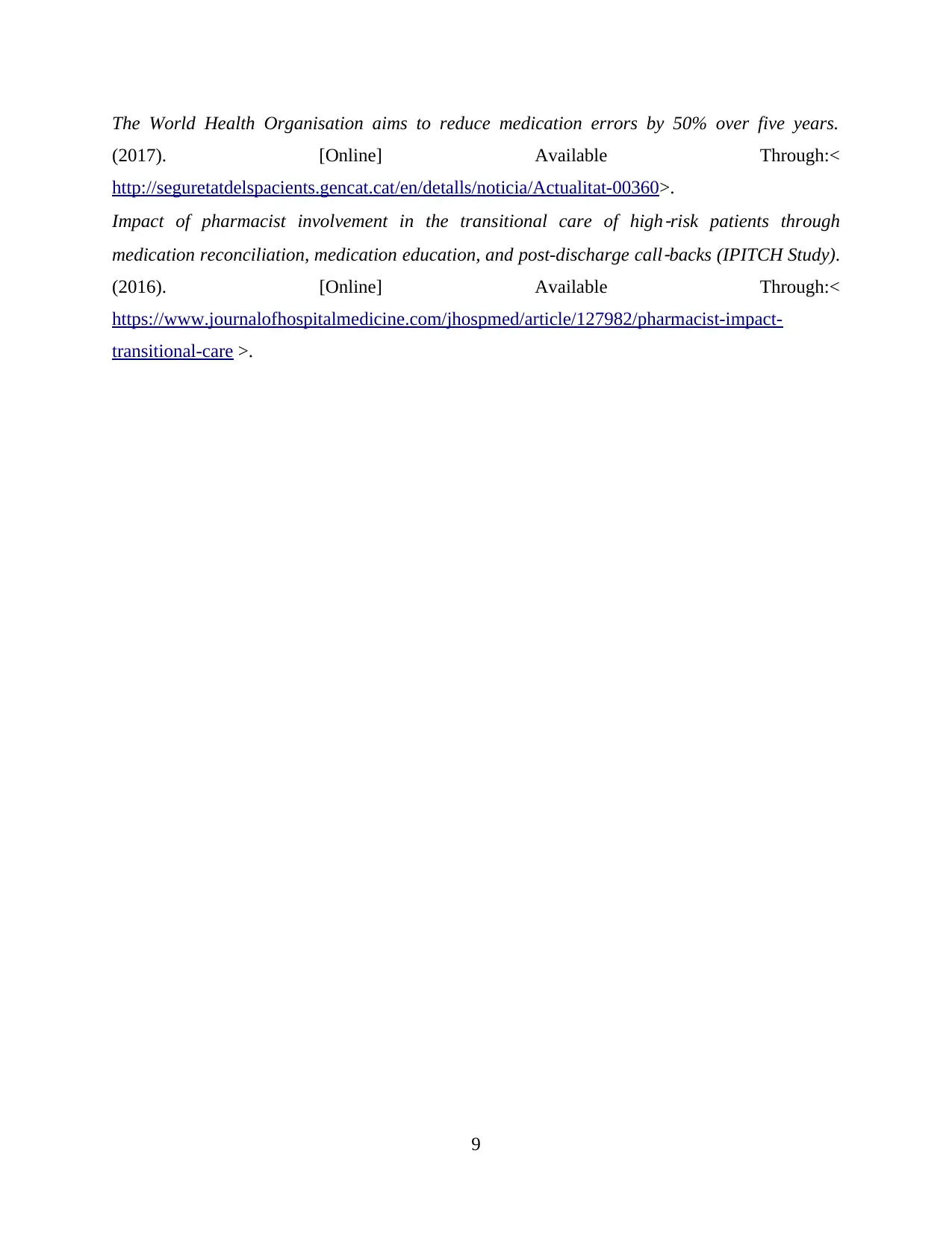
The World Health Organisation aims to reduce medication errors by 50% over five years.
(2017). [Online] Available Through:<
http://seguretatdelspacients.gencat.cat/en/detalls/noticia/Actualitat-00360>.
Impact of pharmacist involvement in the transitional care of high
‐risk patients through
medication reconciliation, medication education, and post-discharge call
‐backs (IPITCH Study).
(2016). [Online] Available Through:<
https://www.journalofhospitalmedicine.com/jhospmed/article/127982/pharmacist-impact-
transitional-care >.
9
(2017). [Online] Available Through:<
http://seguretatdelspacients.gencat.cat/en/detalls/noticia/Actualitat-00360>.
Impact of pharmacist involvement in the transitional care of high
‐risk patients through
medication reconciliation, medication education, and post-discharge call
‐backs (IPITCH Study).
(2016). [Online] Available Through:<
https://www.journalofhospitalmedicine.com/jhospmed/article/127982/pharmacist-impact-
transitional-care >.
9
1 out of 11
Related Documents
Your All-in-One AI-Powered Toolkit for Academic Success.
+13062052269
info@desklib.com
Available 24*7 on WhatsApp / Email
![[object Object]](/_next/static/media/star-bottom.7253800d.svg)
Unlock your academic potential
Copyright © 2020–2025 A2Z Services. All Rights Reserved. Developed and managed by ZUCOL.





